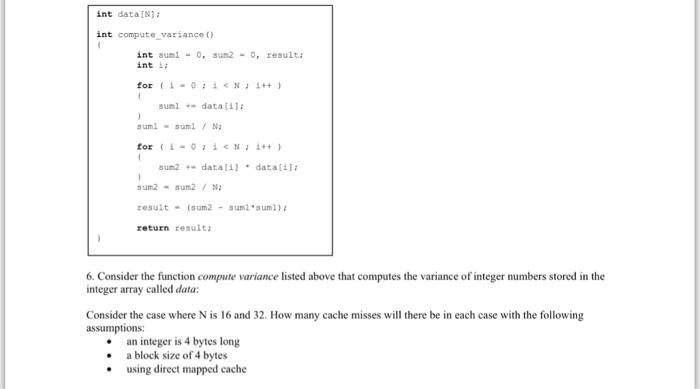Question
int data[N]; int compute variance () ( int sumi 0, sum20, result; int i; for(i=0;i < N;i++) ( suml data[i]; 1 suml sumi /

int data[N]; int compute variance () ( int sumi 0, sum20, result; int i; for(i=0;i < N;i++) ( suml data[i]; 1 suml sumi / N for (i = 0; i < N;i++) ( sum2 data[i] data[i]; 1 sum2 - sum2 / N result (sum2- suml sumi); return result; 6. Consider the function compute variance listed above that computes the variance of integer numbers stored in the integer array called data: Consider the case where N is 16 and 32. How many cache misses will there be in each case with the following assumptions: an integer is 4 bytes long a block size of 4 bytes using direct mapped cache
Step by Step Solution
3.52 Rating (155 Votes )
There are 3 Steps involved in it
Step: 1
91 If N16 then we will suffer a cache miss in the first for loop ...
Get Instant Access to Expert-Tailored Solutions
See step-by-step solutions with expert insights and AI powered tools for academic success
Step: 2

Step: 3

Ace Your Homework with AI
Get the answers you need in no time with our AI-driven, step-by-step assistance
Get StartedRecommended Textbook for
Fixed Income Securities Valuation Risk and Risk Management
Authors: Pietro Veronesi
1st edition
0470109106, 978-0470109106
Students also viewed these Computer Engineering questions
Question
Answered: 1 week ago
Question
Answered: 1 week ago
Question
Answered: 1 week ago
Question
Answered: 1 week ago
Question
Answered: 1 week ago
Question
Answered: 1 week ago
Question
Answered: 1 week ago
Question
Answered: 1 week ago
Question
Answered: 1 week ago
Question
Answered: 1 week ago
Question
Answered: 1 week ago
Question
Answered: 1 week ago
Question
Answered: 1 week ago
Question
Answered: 1 week ago
Question
Answered: 1 week ago
Question
Answered: 1 week ago
Question
Answered: 1 week ago
Question
Answered: 1 week ago
Question
Answered: 1 week ago
Question
Answered: 1 week ago
Question
Answered: 1 week ago
Question
Answered: 1 week ago
View Answer in SolutionInn App



